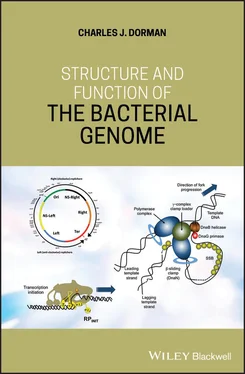1.28 DNA Topoisomerases: DNA Gyrase
Topoisomerases are classed as type I if they change the linking number of DNA in steps of one, and as type II if the linking number changes in steps of two (Champoux 2001; Wang 2002) ( Table 1.1). DNA gyrase is a type II enzyme and it has the property, unique to prokaryotes, of being able to introduce negative supercoils into DNA (Gellert et al. 1976a; Higgins et al. 1978; Nöllmann et al. 2007). This negative supercoiling activity is ATP dependent and there is an ATP‐binding site in the B subunit of gyrase (Gellert et al. 1979; Mizuuchi et al. 1978). Gyrase is an A 2B 2hetero‐tetramer and it is essential; knockout mutations in either of the genes that encode its A ( gyrA ) or B ( gyrB ) subunits are lethal (Bates and Maxwell 2005). Its essentiality has made gyrase a very attractive target for antimicrobial therapy and a number of drugs are available that target its subunits (Collin et al. 2011; Maxwell 1999). The coumarin class of antimicrobials have been particularly useful as research tools because they compete with ATP for access to the B subunit ATPase and inhibit gyrase activity without inducing the SOS response (DeMarini and Lawrence 1992; Gellert et al. 1976b; Gormley et al. 1996; Pugsley 1981; Sugino and Cozzarelli 1980; Sugino et al. 1978). In contrast, those drugs (e.g. quinolones) that inhibit the A subunit during DNA cleavage and religation cause DNA damage that results in induction of the SOS response (Gellert et al. 1977), something that can complicate experimental design and data interpretation. Gyrase also has an ATP‐independent DNA relaxing activity that is unmasked only in the absence of ATP (Gellert et al. 1977; Higgins et al. 1978; Williams and Maxwell 1999). The ATP‐dependent mechanism by which gyrase introduces negative supercoils into DNA is also capable of relaxing positive supercoils (Ashley et al. 2017). This activity is especially important when gyrase processes the positively supercoiled DNA that is a by‐product of transcription and DNA replication (Koster et al. 2010) (Figures 1.14and 1.15). DNA gyrase in living cells responds to the [ATP]/[ADP] ratio, linking the management of DNA topology to the metabolic activity of the bacterium (Hsieh et al. 1991a,b; Snoep et al. 2002; van Workum et al. 1996). Gyrase activity is also tuned in living bacteria by stresses such as the acidification of the bacterial cytosol that accompanies adaptation to acid stress (Colgan et al. 2018).
1.29 DNA Topoisomerases: DNA Topoisomerase IV
Topo IV was discovered in E. coli 14 years after gyrase, its type II topoisomerase companion (Kato et al. 1990) ( Table 1.1). It is encoded by two genes, parC and parE , whose names hint at a defect in chromosome partitioning that is associated with mutants with a topo IV deficiency (Kato et al. 1990). Topo IV is an ATP‐dependent topoisomerase but, unlike gyrase, which it closely resembles in amino acid sequence and subunit structure, it cannot introduce negative supercoils into DNA. Instead, Topo IV relaxes both positively and negatively supercoiled DNA and is an important DNA decatenase (Bates and Maxwell 2007; Crisona and Cozzarelli 2006; Kato et al. 1992; Peng and Marians 1993; Zawadzki et al. 2015). Its relationship with the MukBEF SMC‐like complex is emerging as one of Topo IV's most physiologically significant functions, one that is important for the correct spatiotemporal management of chromosome replication, architecture, and segregation during the cell cycle ( Section 1.21).
1.30 DNA Topoisomerases: DNA Topoisomerase I
The principal source of relaxation activity for negatively supercoiled DNA is Topo I, a monomeric, ATP‐independent enzyme that is encoded by the topA gene in the Ter macrodomain (Margolin et al. 1985) ( Table 1.1). This enzyme also has a catenase/decatenase activity on double‐stranded circular DNA with single‐stranded regions (Terekhova et al. 2012; Tse and Wang 1980) and prevents over‐replication of the chromosome originating at oriC (Usongo and Drolet 2014). Topo I is a type I topoisomerase that has a ‘swivelase’ activity. It cuts one of the two DNA strands in a negatively supercoiled molecule, forming a covalent link to the cut strand, and allows the torsional strain in the DNA to drive the rotation of the intact strand through the gap (Kirkegaard and Wang 1978). The result is an increase of 1 in the linking number of the DNA (Bates and Maxwell 2005). The topA gene is not essential, although knockout mutants grow slowly (Margolin et al. 1985; Sternglanz et al. 1981). Bacteria that lose Topo I through topA knockout mutations can compensate in different ways, restoring a growth rate that is close to that of wild‐type strains (Raji et al. 1985; Richardson et al. 1984). One option is to acquire non‐lethal mutations in gyrA or gyrB that result in the expression of a gyrase with a reduced negative supercoiling activity (DiNardo et al. 1982; Pruss and Drlica 1985; Pruss et al. 1982, 1986; Richardson et al. 1984, 1988). Another possibility exploits the amplification of the copy number of the parC and parE genes, resulting in increased expression of Topo IV. In these strains the elevated expression of Topo IV with its DNA‐relaxing activity can compensate for the missing Topo I, restoring the growth rate of the mutant to one that is similar to wild type (Dorman et al. 1989; Free and Dorman 1994; McNairn et al. 1995). Bacteria that are not exposed to stressful growth conditions such as elevated temperature, low pH, or raised osmotic stress or lack of oxygen do not require compensatory mutations in order to display normal rates of growth (Ní Bhriain and Dorman 1993). This suggests that a link exists between environmental stress and the management of DNA supercoiling in bacteria (Dorman and Dorman 2016).
1.31 DNA Topoisomerases: DNA Topoisomerase III
Topo III is a second type I topoisomerase that, like Topo I, is an ATP‐independent monomeric enzyme ( Table 1.1). It is encoded by the topB gene and is not essential for the survival of the bacterium (Usongo et al. 2013). However, mutants deficient in both Topo I and in Topo III do not survive (Stupina and Wang 2005). Topo III has weak DNA‐relaxing activity and functions principally as a decatenase (Nurse et al. 2003; Perez‐Cheeks et al. 2012). Its apparent weakness as a DNA‐relaxing enzyme compared with Topo I arises from a difference in the mechanisms used by the two topoisomerases: Topo I operates in a processive manner with short pauses between processive runs, whereas Topo III takes long pauses, leading to a relaxing process with an overall rate that seems slower (Terekhova et al. 2012). While Topo I plays an important role in controlling the frequency of chromosome replication initiation at oriC , Topo III contributes to the management of replication fork collision in the Ter macrodomain (Suski and Marians 2008). In fact, all four topoisomerases are important components of the chromosome replication machinery and display both a division of labour and an interesting degree of redundancy that allows the cell to continue to function even if one of the enzymes experiences interference.
1.32 DNA Replication and Transcription Alter Local DNA Topology
The linking number of DNA is changed at a local level by the processes of transcription and DNA replication. In 1987, Liu and Wang proposed, in a landmark theoretical paper, that the process of transcription would induce overwinding of the DNA template ahead of RNA polymerase and underwinding behind (Liu and Wang 1987) ( Figure 1.15). Experimental studies provided support for the proposal, leading to the realisation that topoisomerases play important roles in transcription by relieving the torsional stress that the process creates (Ahmed et al. 2017; Chong et al. 2014; Higgins 2014; Rahmouni and Wells 1992; Rani and Nagaraja 2019; Wu et al. 1988). The role of local DNA supercoiling in the modulation of transcription and in gene‐to‐gene communication will be addressed in Section 8.2. Here we will consider the impact of transcription on nucleoid architecture and on DNA replication.
Читать дальше












